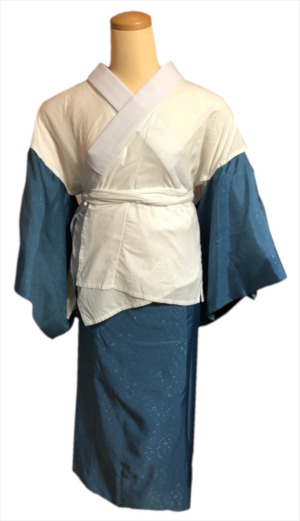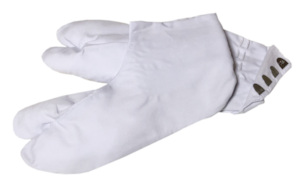Kimono accessories

You need many accessories to wear kimono because it doesn’t have any zippers and buttons.
So usually use cords, belts and sashes. Those kimono accessories have unique names.
For kimono and juban
Himo

himo : a long and thin fabric
Himo changes its name depending on where to use, such as koshihimo, munahimo and karihimo. The most recommended material is 100% wool called muslin.
koshihimo : It is used to secure kimono on your body by tying firmly. It is tied around the waist like a belt for bottoms. It is the most important thing when wearing kimono.
munahimo : It is used to keep the position of the collar.
karihimo : It is used to hold the shape of obi temporarily in the procedure of tying.
Datejime

datejime : a thin sash / belt
This is a traditional datejime made in Hakata.

This is datejime belt with a hook and loop fastener.
Datejime is a thin sash or belt to make kimono and juban fit your body.
Datejime keeps muna-himo, kimono belt and the position of the collar.
Datejime is effective to keep the V-shape of the collar beautiful.
Kimono belt

kimono belt / korin belt
Kimono belt is used instead of himo.
The belt is easy for your body because it is stretchable.
Erishin

erishin : interlining of the collar / collar stiffener
By using erishin, the shape of the collar is kept neat.
Haneri

haneri : exchangeable collar / decorative collar
Haneri is a piece of cloth.
It is one of the items to show your originality.
Change the collar when it is dirty.
White is a basic color. It makes your face brighter as using a reflector board.
Refer to How to sew haneri
Kasane-eri (date-eri)

kasane-eri (date-eri) : layered collar / decorative collar
Kasane-eri is a decorative collar and mainly used for formal kimono, such as furisode, houmongi and tomesode without hiyoku.
Kasane-eri or date-eri upgrades your kimono style.
Refer to How to sew kasane-eri
For obi
Obimakura

obimakura : obi pad / pad for obi
Obimakura is a pad that keeps the shape of obi beautiful.
It is necessary when making otaiko musubi.
Obi-ita

obi-ita : a board for obi
Obi-ita is a board that keeps the surface of obi smooth.
It is used by sandwiching it between obi layers.
Sanjuhimo

sanjuhimo : a triple elastic band for tying obi
Sanjuhimo consists of a piece of fabric tape and triple elastic bands to secure a shape of obi.
Sanjuhimo is often used to tie obi for furisode. It enables you to create various shapes of obi tying.
Refer to How to make gojuhimo
Obiage

obiage : a long and wide strip of cloth for obi
Obiage is a decorative cloth supporting the shape of otaiko on the back by covering the pad called obimakura. The color accentuates your kimono style.
Refer to How to tie obijime and obiage
Obijime

obijime : a cord for obi / final cord
Obijime is a decorative cord to secure obi in place.
Firmly tying obijime keeps obi shape.
Refer to How to tie obijime and obiage
Obidome

obidome : an accessory for obi
Obidome is an accessory for obi. It is good to add it when you feel that the kimono coordination is not enough. It accentuates a simple obi .
Netsuke

netsuke : an ornament accessory for kimono / a charm accessory / carved Japanese ornament
Netsuke consists of an ornament, strap and small plate. It is used to decorate your kimono style. There are various kinds of ornaments, such as animals, flowers and so on.
Originally it is used to tether a small container to obi or kimono.
Undergarments
Hadajuban

hadajuban : underwear for kimono
Hada-juban is front open underwear for the upper body. It is usually made of cotton.
You can wear a camisole instead.
Refer to Underwear for kimono
Susoyoke

susoyoke : underwear for lower body / wrap petticoat
Sosoyoke is a type of kimono underwear that wraps the lower body to shape and keep the body warm.
Refer to Underwear for kimono
kimono slip

kimono slip : a slip for kimono / one-piece underwear for kimono
Young women often wear a kimono slip for yukata in summer.
Refer to Underwear for kimono
Wasou bra

wasou bra : a bra for kimono / Japanese bra
Wasou bra is a functional brassiere to make the breasts flat. It helps you put on kimono easily and neatly.
Refer to Underwear for kimono
Hosei-yogu

hosei-yogu : padding
Padding is used to make the body line smooth.
“No hip and no waist” is one of the keys to wear kimono beautifully.
That’s why padding is often used. The other reason is that kimono is sewn in straight lines. Wearing kimono is just like wrapping the body with one sheet of cloth. It is a little bit difficult to wrap a curvy body with it.
Refer to Padding for wearing kimono
Juban

nagajuban : one-piece undergarment for kimono
Nagajuban is an undergarment that shows its collar partly. Naga means long.
Refer to How to put on nagajuban

nibushiki nagajuban : a two-piece undergarment for kimono
The under skirt can be adjustable. A two piece juban may be more useful than one-piece juban.
Footwear
Tabi

tabi : traditional Japanese socks / a pair of split toe socks
Tabi are traditional Japanese split toe socks which have four or five kohaze hooks and ukeito eyes. Those hooks are small metal pieces and eyes are long stitches on the side of the ankles. Tabi are worn by fastening with them.
Usually we don’t wear tabi when wearing yukata.
Refer to How to put on tabi
Zouri

zouri : traditional Japanese sandals / traditional Japanese footwear
Traditional sandals for women in kimono.
hanao : sandal straps
dai : soles
Hanao can be adjusted to fit your feet. You can select hanao and dai as you like at a zouri shop.
Geta

geta : wooden clogs / traditional Japanese footwear
Geta consists of straps and wooden soles.
We wear them mainly for yukata.
In Japan, there is a custom to take footwear off when people enter houses. Zouri and geta are very convenient and easy to take them off and put them on.
Please let me know if you have a good idea to explain kimono accessories!